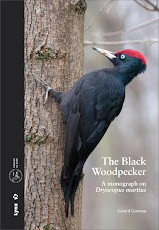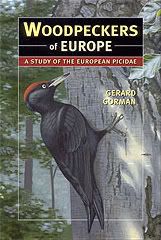Tuesday 28 December 2010
Foraging holes made by Black Woodpecker
Sunday 19 December 2010
Typical feeding stump of White-backed Woodpecker
Thursday 9 December 2010
Tuesday 23 November 2010
Wednesday 17 November 2010
Wednesday 10 November 2010
Wednesday 3 November 2010
Recommended Reading: The Cult of the Green Bird
Wednesday 27 October 2010
Green Woodpecker foraging on thatched roof
Thursday 21 October 2010
Recommended Reading: Schwarzspecht, Grauspecht, Grunspecht
Friday 15 October 2010
Anvil of Great Spotted Woodpecker
Sunday 10 October 2010
Keystone Species
Saturday 2 October 2010
Friday 1 October 2010
Gallery: Black Woodpecker
 Black Woodpecker Dryocopus martius about to fly. Taken by Jari Peltomäki in Finland.
Black Woodpecker Dryocopus martius about to fly. Taken by Jari Peltomäki in Finland.
Sunday 26 September 2010
Black Woodpecker carrying faecal sac

Wednesday 22 September 2010
Nest-Box Damage
 Some woodpeckers will open up nest-boxes, which have been erected for songbirds, in order to get at the chicks inside. They usually do this by enlarging the entrance hole. Here is an example of a nest-box that a woodpecker (perhaps more than one bird) has worked upon. In fact, the whole dead tree has been a foraging site. It is hard to say which species did this, indeed several species may have visited this tree. Photo taken near Brzeszcze, Poland, September, 2010.
Some woodpeckers will open up nest-boxes, which have been erected for songbirds, in order to get at the chicks inside. They usually do this by enlarging the entrance hole. Here is an example of a nest-box that a woodpecker (perhaps more than one bird) has worked upon. In fact, the whole dead tree has been a foraging site. It is hard to say which species did this, indeed several species may have visited this tree. Photo taken near Brzeszcze, Poland, September, 2010.
Tuesday 14 September 2010
Gallery: Wryneck
Wednesday 8 September 2010
Tuesday 31 August 2010
Wednesday 25 August 2010
Black Woodpeckers - changing over at the nest
Wednesday 18 August 2010
Woodpecker Feeding Signs
 I have posted quite a few photos of the marks, mainly holes, that woodpeckers leave on trees when feeding. Many are diagnostic or at least can be narrowed down to a few species. Of course, knowing the range and habitat preferences of each species also helps when wishing to name the woodpecker that made any markings found. But sometimes, with some feeding marks, I would say that it is impossible to positively state which species made them. Here in this photo is an example. It is an old, rotten beech tree riddled with fungi and the holes and marks of a feeding woodpecker or woodpeckers. I took it in an upland forest in Slovakia where up to 8 woodpecker species occur and most of them could have fed here.
I have posted quite a few photos of the marks, mainly holes, that woodpeckers leave on trees when feeding. Many are diagnostic or at least can be narrowed down to a few species. Of course, knowing the range and habitat preferences of each species also helps when wishing to name the woodpecker that made any markings found. But sometimes, with some feeding marks, I would say that it is impossible to positively state which species made them. Here in this photo is an example. It is an old, rotten beech tree riddled with fungi and the holes and marks of a feeding woodpecker or woodpeckers. I took it in an upland forest in Slovakia where up to 8 woodpecker species occur and most of them could have fed here.
Tuesday 10 August 2010
Recent Article on Woodpeckers
 You may like to check-out an article by myself entitled A FOREST FRIENDLY SOCIETY in BIRD ART & PHOTOGRAPHY magazine (Issue 2, Summer 2010). This new mag is published in the UK. My article, which is illustrated with some great colour photos from around the continent, deals with Europe's ten picid species and how they are able to live together with minimum conflict.
You may like to check-out an article by myself entitled A FOREST FRIENDLY SOCIETY in BIRD ART & PHOTOGRAPHY magazine (Issue 2, Summer 2010). This new mag is published in the UK. My article, which is illustrated with some great colour photos from around the continent, deals with Europe's ten picid species and how they are able to live together with minimum conflict.
Monday 2 August 2010
Black Woodpecker foraging site
Sunday 25 July 2010
Heinz Sielmann film clips

Friday 16 July 2010
Syrian Woodpeckers in action
 This great action shot of Syrian Woodpeckers Dendrocopos syriacus (female in the air, male on the ground) was taken in Bulgaria by Mladen Vasilev. See more of his woodpecker and other wildlife photos here.
This great action shot of Syrian Woodpeckers Dendrocopos syriacus (female in the air, male on the ground) was taken in Bulgaria by Mladen Vasilev. See more of his woodpecker and other wildlife photos here.
Tuesday 13 July 2010
Black Woodpecker male at its hole
Monday 5 July 2010
Monograph on Black Woodpecker
 I am very pleased to announce that I have recently sent a manuscript on Black Woodpecker to my publisher. This monograph will be published within 12 months. It is the result of 20 years of work... observing pairs of this magnificent woodpecker and scouring the existing literature... and 2 years of writing. Here is a sneak preview of a draft sketch of one of Szabolcs Kokay's black and white illustrations which will be included in the book. There will also be 2 colour plates about 20 colour photographs.
I am very pleased to announce that I have recently sent a manuscript on Black Woodpecker to my publisher. This monograph will be published within 12 months. It is the result of 20 years of work... observing pairs of this magnificent woodpecker and scouring the existing literature... and 2 years of writing. Here is a sneak preview of a draft sketch of one of Szabolcs Kokay's black and white illustrations which will be included in the book. There will also be 2 colour plates about 20 colour photographs.
Thursday 1 July 2010
Great Spotted Woodpecker Holes in Shed

One of the main areas of conflict between woodpeckers and people concerns the damage that they can do to wooden buildings. In some regions, they regularly bore holes in log cabins, barns and even occupied homes. People who, though being “bird-lovers”, sometimes ask for certain “crazy” individuals that continually hack holes in their summer houses to be culled. The precise reason why some birds do this is unclear, but presumably they are searching for prey that reside in the timber walls; it has even been suggested that high-frequency electrical sounds in the building fool the birds into thinking that invertebrates are present. This photo shows the work of a Great Spotted Woodpecker D. major on on a shed near Pasohlavky, Czech Republic, in April 2010.
Sunday 20 June 2010
More Black Woodpecker Feeding Holes
Saturday 12 June 2010
Sunday 6 June 2010
Tuesday 1 June 2010
Conifer Cones Wedged By Great Spotted Woodpecker
Friday 21 May 2010
Black Woodpecker Foraging Holes
Wednesday 12 May 2010
White-backed Woodpecker Tree Stump
Monday 10 May 2010
Gallery: adult male Green Woodpecker
Friday 30 April 2010
Saturday 24 April 2010
Gallery: Grey-headed Woodpecker Female
Tuesday 20 April 2010
New Black Woodpecker Feeding Holes
 Newly made holes of Black Woodpecker Dryocopos martius. Note that the tree is hollow inside and this is why the bird hacks into it. The bird has not killed this tree as it is already doomed and infested with invertebrates. Photo kindly sent to me by Edward Mayer, taken in a park in Potsdam, Germany.
Newly made holes of Black Woodpecker Dryocopos martius. Note that the tree is hollow inside and this is why the bird hacks into it. The bird has not killed this tree as it is already doomed and infested with invertebrates. Photo kindly sent to me by Edward Mayer, taken in a park in Potsdam, Germany.
Sunday 11 April 2010
Holes in Telegraph Pole
Monday 29 March 2010
Black Woodpecker Holes
Sunday 21 March 2010
Gallery: Black Woodpecker at nest hole
Sunday 14 March 2010
Gallery: Green Woodpecker adult female
Monday 8 March 2010
Old Feeding Holes of Black Woodpecker
Monday 1 March 2010
Great Spotted Woodpecker on the Irish News
Friday 26 February 2010
Black Woodpecker Tail Feather
Monday 22 February 2010
Tawny Owl in Black Woodpecker Hole
Monday 15 February 2010
Woodpecker Photographers: Peter Csonka
 Peter Csonka, from Hungary, is another photographer whose work includes some great shots of European woodpeckers. This fine photo of a male Black Woodpecker Dryocopos martius was taken near Tata, Hungary. Take a look at more of his work: Peter Csonka
Peter Csonka, from Hungary, is another photographer whose work includes some great shots of European woodpeckers. This fine photo of a male Black Woodpecker Dryocopos martius was taken near Tata, Hungary. Take a look at more of his work: Peter Csonka
Tuesday 9 February 2010
Lesser Spotted Woodpecker: record age for UK
 This adult female Lesser Spotted Woodpecker Dendrocopos minor was caught at Beale Park, near Reading, Berkshire, UK by the River Thames on the 6th February 2010 during a ringing session. The bird was found to already have a ring and when checked it was discovered to have been ringed at the same site in September 2003. For a small bird this seemed to be a very good age and it was later confirmed that this was the oldest know Lesser Spotted Woodpecker for the UK, at 6 years 4 months and 8 days. Thanks to Danny Alder for this snippet and to David Baker for the photograph.
This adult female Lesser Spotted Woodpecker Dendrocopos minor was caught at Beale Park, near Reading, Berkshire, UK by the River Thames on the 6th February 2010 during a ringing session. The bird was found to already have a ring and when checked it was discovered to have been ringed at the same site in September 2003. For a small bird this seemed to be a very good age and it was later confirmed that this was the oldest know Lesser Spotted Woodpecker for the UK, at 6 years 4 months and 8 days. Thanks to Danny Alder for this snippet and to David Baker for the photograph.
Friday 5 February 2010
Picid Pics
 A new site for all interested in woodpeckers is Picid Pics. It contains many great photos of wrynecks, piculets, woodpeckers and secondary-users of woodpecker cavities.
A new site for all interested in woodpeckers is Picid Pics. It contains many great photos of wrynecks, piculets, woodpeckers and secondary-users of woodpecker cavities.
Wednesday 3 February 2010
Woodpecker Photographers: Laszlo Nehezy

Thursday 21 January 2010
Woodpecker Photographers: Jari Peltomäki

















.jpg)

_1.jpg)















.jpg)




